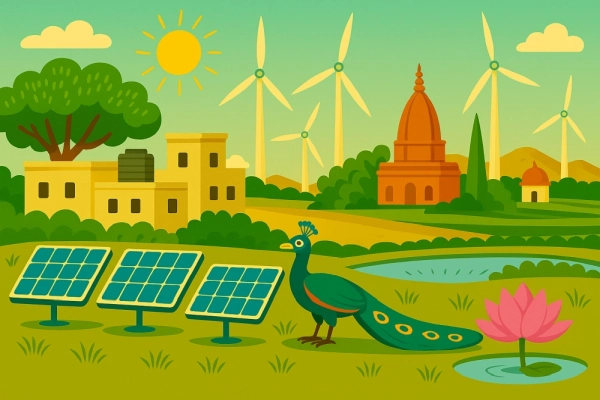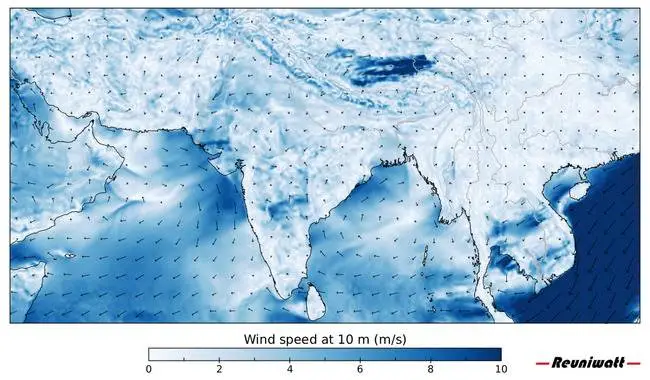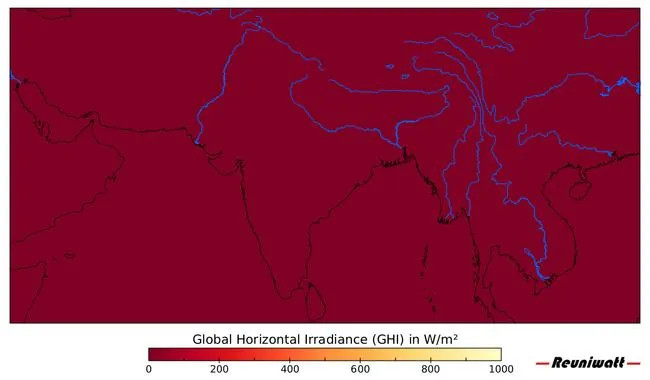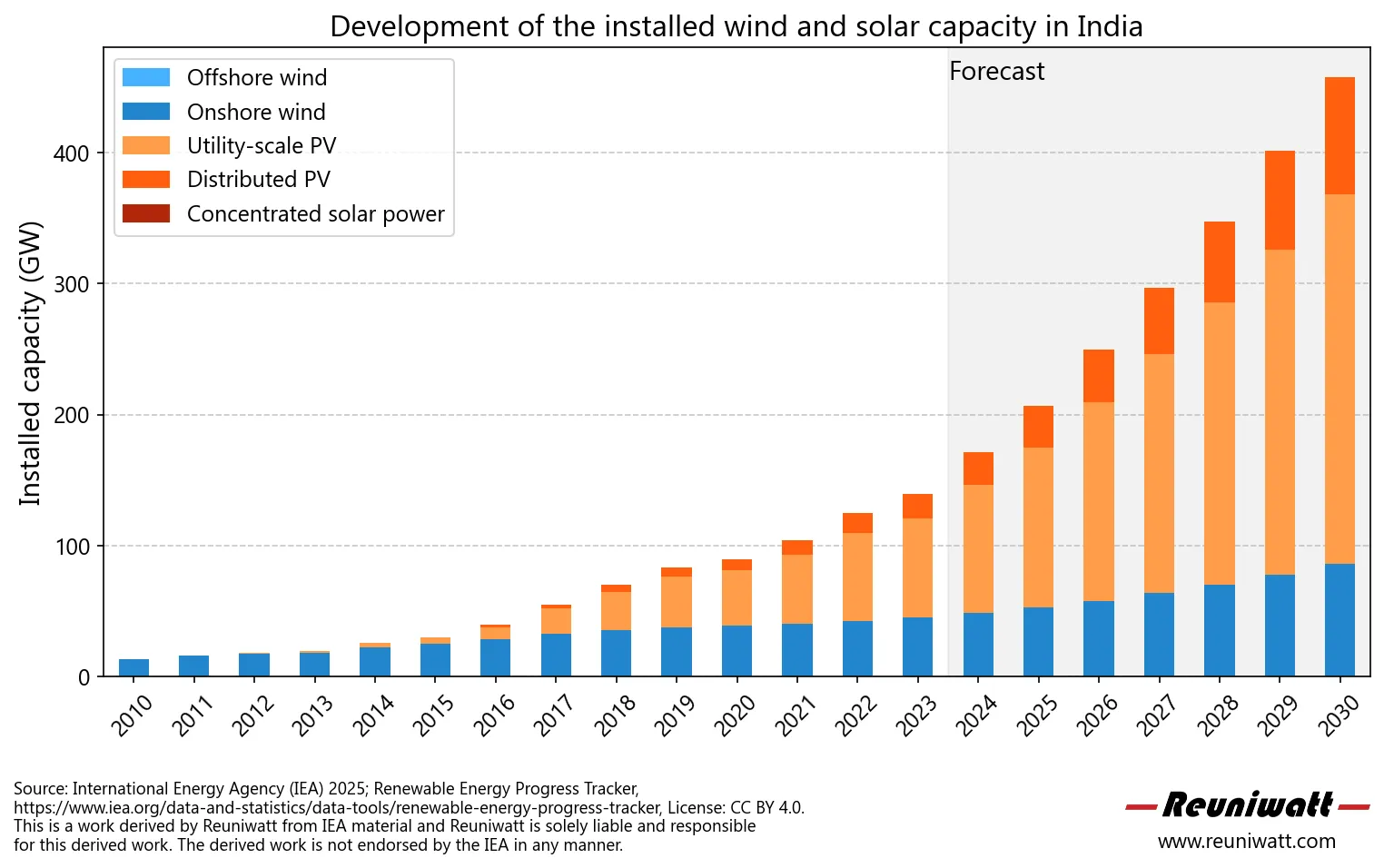India is rapidly emerging as a major force in the global renewable energy landscape. With abundant sunshine and growing wind potential, the country is expanding its solar and wind capacity to meet rising energy demands. Ambitious government targets and large-scale projects are driving progress, though challenges remain in grid infrastructure and access to financing.
Renewables market in India
India’s renewable energy market is one of the most dynamic and rapidly expanding in the world, driven by the government’s ambitious climate commitments and the country’s growing energy demands. With a target of achieving 500 gigawatts (GW) of non-fossil fuel capacity by 2030, India is positioning itself as a global leader in clean energy. As of 2023, India had installed over 180 GW of renewable energy capacity, accounting for more than 43% of the country’s total installed power capacity. This includes solar power (around 73 GW), wind power (approximately 44 GW), small hydropower, biomass, and waste-to-energy projects. The growth has been propelled by initiatives like the National Solar Mission, which has significantly boosted solar energy adoption across residential, commercial, and industrial sectors. The government’s push for renewable energy is also closely tied to its broader developmental goals, including energy security, job creation, and reducing pollution levels in urban areas.
Solar energy has become the cornerstone of India’s renewable strategy, thanks to its abundant solar resources and decreasing solar panel costs. India is now the fourth-largest solar power producer globally. The country has seen rapid growth in both utility-scale solar farms and rooftop solar projects, particularly in states like Rajasthan, Gujarat, and Karnataka. India’s target of 280 GW of solar capacity by 2030 underscores the central role solar power will play in meeting future energy demands. Wind energy also holds a prominent place, especially in southern and western regions where wind conditions are favorable. With around 44 GW of installed capacity, India ranks fourth globally in wind power generation. However, the wind sector’s growth has been slower in recent years due to challenges related to land acquisition, infrastructure limitations, and policy uncertainties. To overcome these issues, India is focusing on offshore wind development, with potential projects planned along the coasts of Gujarat and Tamil Nadu, which could significantly enhance the country’s renewable portfolio.

Looking forward, India’s renewable energy growth will increasingly depend on integrating diverse energy sources and addressing grid-related challenges. The government is investing in large-scale hybrid projects that combine wind, solar, and battery storage to ensure a stable power supply and reduce the intermittency issues typically associated with renewables. Projects like the Green Energy Corridor aim to strengthen transmission infrastructure, facilitating the efficient transfer of renewable power from generation centers to consumption hubs. Additionally, India is making significant strides in the green hydrogen sector, targeting an annual production capacity of 5 million tonnes by 2030. Green hydrogen is expected to play a critical role in decarbonizing hard-to-abate sectors such as steel, cement, and heavy transport. International collaborations, favorable policies, and increasing private sector investments are likely to accelerate progress in this space. Despite challenges such as financing, regulatory hurdles, and grid integration, India’s renewable energy sector is well-positioned for sustained growth, making it a pivotal player in the global transition to clean energy.
Wind and solar capacities in India
India’s renewable energy sector has witnessed remarkable growth, particularly in wind and solar power capacities. As of December 2023, the country’s cumulative wind energy capacity reached approximately 44.7 gigawatts (GW), marking an increase from 41.9 GW at the end of 2022. This growth was bolstered by the addition of 2.8 GW of new wind capacity in 2023, representing a 56% surge compared to the 1.8 GW added in 2022. Projections indicate that India’s annual wind capacity additions are set to more than double, averaging 7.1 GW in the next two financial years, which would elevate the total installed wind capacity to around 63 GW by the fiscal year 2026-27.

The solar energy sector in India has experienced even more significant expansion. In the calendar year 2024, the country added a record 25.2 GW of solar photovoltaic (PV) capacity, a substantial increase from the 8.3 GW added in 2023. This brought the total installed solar capacity to approximately 100.1 GW by January 2025. Notably, the states of Rajasthan and Gujarat contributed more than half of the new installations in 2024. Despite this impressive growth in capacity, challenges persist in scaling up power output to match the installed potential. India aims to achieve a total solar capacity of 280 GW by 2030, underscoring its commitment to expanding its renewable energy footprint.

Renewable energy market projections for India
The International Energy Agency (IEA) has highlighted India’s significant strides in renewable energy development, particularly in solar and wind power. The country has set an ambitious target to achieve net-zero emissions by 2070, with a near-term goal of installing 500 gigawatts (GW) of non-fossil fuel power capacity by 2030. To support this, India has implemented initiatives like the Production Linked Incentives scheme, aiming to bolster domestic manufacturing of solar modules, batteries, and other clean energy equipment.

Despite these efforts, the IEA emphasizes that substantial investment is crucial to meet India’s renewable energy objectives. Challenges such as project delays due to land acquisition issues, grid connectivity, and regulatory hurdles persist. The IEA underscores the necessity for enhanced policy measures, improved grid infrastructure, and increased financial commitments to ensure India stays on track with its renewable energy ambitions.
Our activities in India
Reuniwatt has been active in India for several years and is committed to accompany Indian companies in the energy transition. Reuniwatt had already deployed sky cameras in India and is actively looking for collaboration with local actors on the energy market to improve intraday solar and wind forecasting as well as day-ahead solar and wind forecasting and boost assets’ performances. We are present in Asia and we are committed to expand our activities in the region.